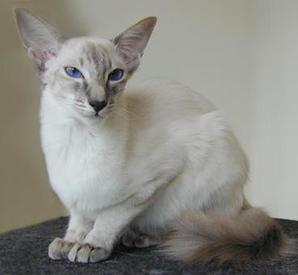
On the whole, the history of the Balinese remains a mystery. Precious little is known about how or where it originally came to be. Its brother, the Siamese, is believed to date back as early as the Egyptians, while the Balinese is thought to be the result of a genetic mutation occurring in the breed. Two Siamese breeders, named Marion Dorsey and Helen Smith, are credited with developing the Balinese after discovering a longhaired cat in their Siamese litters. It is rumoured that the name ‘Balinese’ was given by Helen Smith because she was reminded of the famous dancers of Bali whenever she looked at her cat. The Balinese gained official recognition by the International Cat Association in 1979.
Possessing a slender and athletic body structure, with long legs, large triangular ears, a defined nose and a long, tapering tail, the Balinese is almost identical to the Siamese in all but coat length. The Balinese boasts a single coat and a plumed tail, and is usually observed in colour variations of blue, seal, lilac and chocolate. The eyes are very often blue. Although the cat has a moderate length coat, its tapers naturally away to the tail, thus it does not hide the supple shape of the breed.
The temperament of the Balinese is often described as affectionate, playful and easily engaged, making it a perfect breed for families. The intelligent and curious nature of the Balinese means it benefits from both physical and mental enrichment throughout the day, so interactive toys, scratching posts and plentiful space for play and exercise is essential. Most Balinese are kept as indoor cats because they are relatively rare and expensive. On average, a healthy Balinese will weigh between 8-16 pounds depending on its gender, with a life expectancy of 18-22 years.
Generally speaking, the Balinese is a very healthy all-round breed. Lysosomal Disease is one condition that has been identified in the breed, as has Feline Acromelanism, a condition that causes changes to appear in the coat, as well as changes in temperature. Both conditions are documented, although not with any great prevalence.
Do you own a Balinese? Let others know what they're like!
Related products
Classic Magic Of The Orient
from £8.20
Advantage 80 Spot On Flea Control Large Cats and Rabbits
from £12.95
Advantage 40 Spot On Flea Control Cats, Small Dogs and Rabbits
from £12.95
Advantage 100 Spot On Flea Control Medium Dog
from £12.95
Advantage 250 Spot On Flea Control Large Dog
from £12.95
Drontal Tasty Bone Wormer Tablets for Small & Medium Dogs (2 to 20kg)
from £2.15
TermaWorm™ Tablets for Cats & Dogs
from £1.59
FRONTLINE Plus Flea & Tick Treatment Dogs & Cats
from £17.49